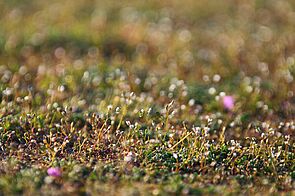Flourishing diversity in early spring—Report of the First Inspection on April 14, 2022
Authors: Irene Drozdowski und Alexander Mrkvicka
Photography authors: Irene Drozdowski, Jennifer Fischer, Alexander Mrkvicka
Landschaftspflegeverein Thermenlinie-Wienerwald-Wiener Becken
On April 14, the biologists of the Landscape Conservation Association Thermenlinie-Wienerwald-Wiener Becken were out and about in the green spaces of Seibersdorf for the first time this year. The goal of the inspections is to document the biological diversity on site. Although mowing has been frequent for many years, a rich diversity of flowers is already visible in the first spring, which in turn is the source of life for many insects.
The plants also show that the different areas do not share many commonalities. The palette ranges from very dry, gravelly areas to more nutrient-rich and vigorous meadows. This increases the diversity! In the following, the new animal and plant species found during the first inspection are listed and explained.
Rue-Leaved Saxifrage (Saxifraga tridactylites)—The low-competitive Rue-Leaved Saxifrage (Saxifraga tridactylites) lives on sandy and gravelly soils. It disappears when the plant cover becomes denser. Its seeds are long-lasting in the soil. If the soil is opened up again—for example by excavation work (also by rabbits)—the Rue-Leaved Saxifrage then reappears unexpectedly.
Garden Bumblebee (Bombus hortorum)—The peaceful, long-trunked Garden Bumblebee (Bom-bus hortorum) prefers to lay its nest in abandoned mouse nests in the ground, more rarely in abandoned bird nests. The queens, which are the only ones to survive the winter, appear from the beginning of March to the end of April, depending on the weather. The colony is rather small, with about 50 to 120 workers. While the queen lives about 1 year, a worker lives only about 6 weeks.
Common Whitlowgrass (Draba verna)—The Common Whitlowgrass (Draba verna) is tiny and a typical inhabitant of open, dry, nutrient-poor habitats. The plant survives the summer heat and drought as a seed that sprouts in late autumn. In spring, it forms dense flower carpets of tiny plants that are only discovered when you take a closer look.
Lesser Celandine (Ranunculus ficaria)—Lesser Celandine (Ranunculus ficaria) occurs naturally in sparse woods or in parks under trees and in shady places. Its shiny yellow flowers act like a parabolic mirror and warm the inside of the flower by several degrees. Small insects, therefore, like to sit in the flowers in spring to warm themselves up.

















